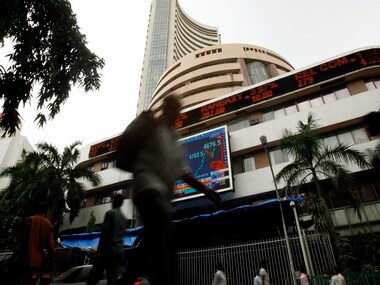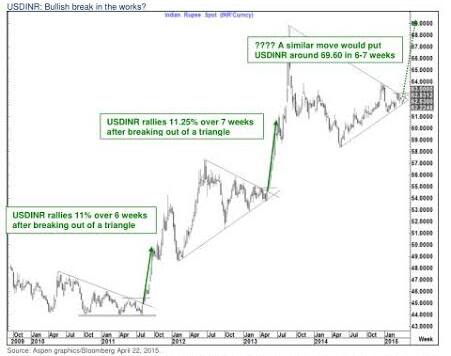By Rajesh Pandathil & Kishor Kadam Has Indian equity markets entered a bear phase? Consider these data points: In the past nine trading sessions, barring one, the Sensex have recorded a decline. During the period, the Sensex shed 1867.45 points or 6.43 percent (including today’s 260.95 points or 0.95 percent) to 27,176.99. The Sensex is down by 2847.75 points or 9.48 percent lower from its peak of 30024.74 recorded on 4 March when the RBI cut its benchmark repo rate by 25 basis points to 7.50 percent for the second time this year. During the period, the rupee has depreciated by 1.78 percent or 1.11 paise to 63.64 against the US dollar. While a nine-session trend cannot be corroborated to assume that the market may have entered a bear phase, there could be worrying signs of a sell-off in Indian equities. A technical analysis note by Citi recently raised the question whether the Indian bull market is about to derail. “A US equity market correction, if seen, would likely reverberate through global markets and cause other popular equity indices to come under some pressure,” the note said. “The Sensex and Nifty indices are beginning to show signs of caution and breaks below the 26,700-27,248 and 8,025-8,270 areas, respectively, could lead to losses of over 20%,” it said. Apart from these technicalities, there are other reasons to believe that the sentiment for Indian equities is downbeat for now. First and foremost reason is the FIIs’ disenchantment with the Indian markets after the $6 billion tax notices slapped on them by the tax authorities. The government has justified its stance but said the FIIs can go ahead seek redessel from the courts. [caption id=“attachment_2123745” align=“alignleft” width=“380”]  Reuters[/caption] The development has created considerable amount of uncertainty among the institutions, who have pumped in around Rs 1.10 lakh crore into the equity market in over the last 11 months from May 2014, when Narendra Modi came to power promising a business friendly government at the Centre. Secondly, the government has taken some steps in the right direction towards reform, but no big change on the ground situation is visible yet. This has irked some of the investors. “So far, the new government has done nothing but talk, and it is a shame because Modi had experience; he said he knew what needs to be done. He campaigned for many months saying he knows how to fix India, but he has done very little,” hedge fund manager Jim Rogers told the Mint in a recent interview, explaining why he was disillusioned, nearly one year after he bought into India. Thirdly, a crisis is brewing in the rural economy with farm income falling and the debt burden rising. The fall in farm income is already taking a toll on consumption demand and some of the corporate sectors, such as consumer goods and two-wheelers, are bracing for worse days ahead as unseasonal rainfall has damaged standing summer crop, signalling a further decline in farm income. The opposition parties are making the most of the heightened rural distress and have even managed to stall the Land Acquisition Bill. The situation of NPA-ridden banks are more worrisome. According to a report by India Ratings, the unseasonal rainfall and crop damage are likely to impact the profitability of banks by 10 percent. Also, the rating agency expects the agri NPAs of banks to double from the current level. If, as Met has predicted, the monsoon falls short this year again, the troubles in the rural areas will go further deep, impacting the broader economy adversely. Where is the rupee headed? Citi sees pressure on the rupee building up. “Given the large inflow into Indian equities over the past 12 months, INR would likely come under pressure also. A weekly close above 63 would open the way towards 68-69,” it said in the note.  Explaining the graphic above, the brokerage has noted that over the last five years the dollar-rupee has formed a long-term triangle pattern followed by a bullish break. “The previous two breaks were followed by rallies of 11 percent over six weeks and 11.25 percent over 7 weeks, respectively,” it said. The rupee seems to be forming such a pattern again, which means the currency is likely to pierce the record low of 68.85 hit in 2013 and touch 69.60 in 6-7 weeks’ time. The brokerage says the only condition for such a fall is the rupee’s weekly close above 63, which happened last Friday. Moreover, as many experts have already pointed out, the rupee is ‘overvalued’. According to this article by Abheek Barua of HDFC Bank, in the Business Standard, the real effective exchange rate (REER) shows that the Indian currency is about 25 percent overvalued in March 2015. This would also result in its depreciation. This is the reason why CLSA’s senior economist Rajeev Malik expects the rupee to hit 67 but only in a year’s time. “Gradual rupee depreciation has been our view for quite some time… the rupee is overvalued, which is inimical to the government’s agenda of boosting growth,” he has been quoted as saying in a report in ndtv.com.
Citi sees the rupee hitting 69.60 in 6-7 weeks, while CLSA seed the currency at 67 in a year’s time
Advertisement
End of Article
Written by FP Archives
see more


)

)
)
)
)
)
)
)
)



